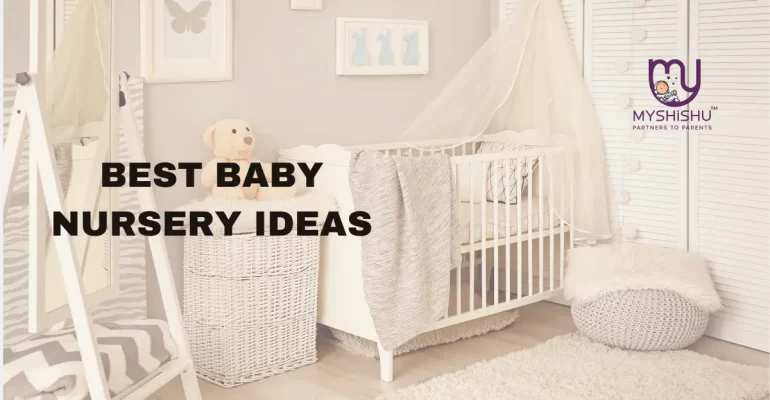Baby Nursery Ideas: Create a Soothing & Serene Space for Your Baby
Baby Nursery Ideas: Create a Soothing & Serene Space for Your Baby
Are you looking for Baby Nursery Ideas? Designing your baby’s room is one of the most fun things you’ll do on the journey to parenthood, and it’s probably the one design-obsessed parents are most excited about. There’s nothing more beautiful than a newborn’s room. You’ll get to pick the cute crib where your little one will fall asleep, and the rug where he’ll start crawling around.
Introduction
Some unique challenges come with designing baby rooms. Aside from being fun and cute, the best nursery designs are practical and comfortable for all involved: parents, siblings grandparents, and caregivers. Believe us, there’s nothing more uncomfortable than sitting in a rocker at 3:00 in the morning or pushing aside toys to get your little one into their crib for a good night’s sleep. The furniture must provide sturdy surfaces and easy-to-store storage space for your baby and his or her belongings.
Explore some Baby Nursery Ideas
A well-designed nursery not only provides a comfortable space for your little one but also enhances the overall aesthetic of your home. Whether you’re a first-time parent or adding to your growing family, here are 15 baby nursery ideas to inspire you to create a cosy and functional space.
1. Start with a Neutral Palette
Opting for a neutral colour palette sets a serene and calming tone for the nursery. Soft shades of white, beige, grey, or pastels create a peaceful environment that promotes relaxation and sleep. Neutral walls also provide a versatile backdrop, allowing you to easily switch up décor elements as your baby grows.
2. Incorporate Soft Textiles
Soft textiles such as plush rugs, cosy blankets, and comfortable bedding are essential for creating a warm and inviting nursery. Look for hypoallergenic fabrics that are gentle on your baby’s delicate skin. Adding layers of texture through curtains, cushions, and upholstered furniture enhances the sensory experience and adds visual interest to the room.
3. Choose Functional Furniture
Invest in furniture pieces that serve multiple purposes to maximize space in the nursery. A convertible crib that can be transformed into a toddler bed as your child grows is a practical choice. Opt for a changing table with built-in storage to keep diapers, wipes, and other essentials organized and within reach. Consider a comfortable rocking chair or glider for late-night feedings and soothing cuddles.
4. Create a Focal Point
Designate a focal point in the nursery to draw attention and add personality to the space. A statement wall adorned with removable wallpaper, decals, or a mural can serve as a captivating focal point. Alternatively, you can showcase a collection of framed artwork, photographs, or a custom-made mobile above the crib to capture your baby’s imagination.
5. Embrace Nature-Inspired Décor
Bring the outdoors inside by incorporating nature-inspired elements into the nursery design. Decorate with botanical prints, woodland creatures, or floral motifs to create a whimsical and enchanting atmosphere. Add potted plants or wall-mounted shelves with greenery to introduce a touch of freshness and promote air quality.
6. Personalize with DIY Touches
Infuse the nursery with your style and creativity by incorporating DIY touches and handmade décor. Create custom wall art, fabric bunting, or embroidered pillows to add a personalized touch to the space. Consider crafting a name banner or monogrammed items to celebrate your baby’s arrival and make the nursery feel truly special.
7. Optimize Lighting
Proper lighting is crucial for creating a comfortable and functional nursery environment. Install adjustable overhead lighting to provide ample brightness during daytime activities and dimmable fixtures for soft, soothing illumination during nighttime routines. Consider adding a whimsical nightlight or string lights to create a cosy ambience and help your baby feel safe and secure.
8. Design a Reading Nook
Encourage a love for reading from an early age by incorporating a cosy reading nook into the nursery design. Set up a comfortable armchair or bean bag chair with a small bookcase or floating shelves stocked with age-appropriate books. Create a cosy corner with plush pillows and blankets where you can snuggle up with your little one and enjoy storytime together.
9. Add Storage Solutions
Effective storage solutions are essential for keeping the nursery organized and clutter-free. Invest in modular shelving units, storage baskets, and bins to corral toys, books, and baby essentials. Utilize under-crib storage for bulkier items and install wall-mounted hooks or pegboards to hang clothing, hats, and accessories within easy reach.
10. Consider Safety Measures
Prioritize safety when designing your baby’s nursery by adhering to recommended guidelines and best practices. Anchor furniture to the wall to prevent tipping, and ensure that electrical outlets are covered with safety plugs. Choose window treatments with cordless designs to eliminate strangulation hazards, and install baby gates to restrict access to potentially dangerous areas.
11. Incorporate Sensory Stimuli
Create a sensory-rich environment in the nursery to stimulate your baby’s development and exploration. Hang a colourful mobile above the crib to captivate your baby’s attention and encourage visual tracking. Incorporate tactile elements such as textured rugs, soft toys, and sensory balls to engage your baby’s sense of touch and promote sensory exploration.
12. Design a Gender-Neutral Space
Opt for a gender-neutral nursery design that transcends traditional stereotypes and allows for versatility and flexibility. Choose décor elements in neutral colours and timeless themes that can easily transition as your child grows. Embrace minimalist design principles and focus on creating a serene and calming space that fosters creativity, imagination, and self-expression.
13. Create a Sleep-Friendly Environment
Promote healthy sleep habits by designing a nursery environment that supports restful sleep. Choose blackout curtains or shades to block out light and create a dark, soothing atmosphere conducive to sleep. Use a white noise machine or soft music to mask household noises and help your baby drift off to sleep more easily. Ensure that the crib is free of soft bedding, pillows, and stuffed animals to reduce the risk of suffocation and Sudden Infant Death Syndrome (SIDS).
14. Incorporate Educational Elements
Integrate educational elements into the nursery design to foster learning and cognitive development from an early age. Hang alphabet or number posters on the walls to introduce early literacy and numeracy concepts. Display age-appropriate toys, puzzles, and books that encourage exploration, problem-solving, and imaginative play. Create a dedicated art corner with washable crayons, markers, and paper to inspire creativity and self-expression.
15. Infuse Personal Touches
Above all, infuse the nursery with personal touches and sentimental items that reflect your family’s values, traditions, and heritage. Display cherished heirlooms, family photographs, or handmade gifts from loved ones to create a sense of connection and belonging. Incorporate meaningful artwork, quotes, or décor pieces that evoke feelings of love, joy, and gratitude, and celebrate the unique journey of parenthood.

Essential Points to Consider When Designing the Perfect Baby Nursery
Designing a nursery involves careful consideration of various factors, from colour schemes and furniture choices to safety measures and organization solutions. In this comprehensive guide, we’ll explore essential points to consider when designing a nursery room for your baby, along with inspiring ideas to help you create the perfect space.
1. Safety First
Safety should always be the top priority when designing a nursery for your baby. Here are some key safety considerations to keep in mind:
- Crib Safety: Choose a sturdy crib that meets current safety standards, with slats no more than 2⅜ inches apart to prevent entrapment. Avoid using drop-side cribs, as they have been deemed unsafe. Ensure that the mattress fits snugly in the crib with no gaps around the edges.
- Secure Furniture: Anchor heavy furniture, such as dressers, bookcases, and changing tables, to the wall to prevent tipping. This is especially important once your baby becomes mobile and starts pulling themselves up on furniture.
- Window Treatments: Use cordless window coverings or keep cords out of reach to prevent strangulation hazards. Install window guards or stops to prevent windows from opening too far.
- Electrical Outlets: Cover electrical outlets with safety plugs or install outlet covers to prevent accidental shocks or burns.
- Soft Bedding: Avoid using soft bedding, including pillows, blankets, and crib bumpers, which can pose a suffocation hazard for infants.
2. Create a Calm and Comfortable Environment
The nursery should be a soothing and relaxing space where both you and your baby can feel comfortable. Consider the following tips:
- Soft Colors: Choose a soft and calming colour scheme for the walls, bedding, and décor. Shades of pastel blue, pink, green, or neutral tones like beige and grey are popular choices for nurseries.
- Cosy Textiles: Incorporate soft textiles such as plush rugs, curtains, and bedding to add warmth and cosiness to the room. Opt for hypoallergenic materials that are gentle on your baby’s sensitive skin.
- Comfortable Seating: Include a comfortable chair or rocking glider where you can nurse, feed, and cuddle your baby. Make sure it has supportive cushions and is positioned near a table or shelf for convenience.
- Temperature Control: Install a thermostat to regulate the temperature in the nursery and ensure that it remains comfortable for your baby. Use a room thermometer to monitor the temperature and dress your baby appropriately for sleep.
3. Functional Furniture
Choose furniture that is both stylish and practical to maximize space and functionality in the nursery. Consider the following essential pieces:
- Crib: Select a safe and durable crib that can be converted into a toddler bed as your child grows. Look for adjustable mattress heights and teething rails for added convenience and safety.
- Changing Table: Invest in a sturdy changing table with ample storage space for diapers, wipes, and other baby essentials. Consider one with built-in shelves or drawers for easy organization.
- Storage Solutions: Incorporate plenty of storage options, such as dressers, bookcases, and baskets, to keep the nursery organized and clutter-free. Utilize vertical space with wall-mounted shelves or floating ledges to maximize storage capacity.
- Multi-functional Pieces: Choose furniture with multiple functions to save space and meet various needs. For example, opt for a crib with an attached changing table or a dresser that doubles as a changing station.
4. Personalize the Space
Infuse the nursery with personal touches and meaningful elements that reflect your style and personality. Here are some ideas:
- Decorative Accents: Add decorative accents such as framed artwork, wall decals, or personalized wall hangings to personalize the space. Consider incorporating elements that reflect your interests, hobbies, or cultural background.
- Name or Initials: Display your baby’s name or initials prominently in the nursery using wall letters, wooden signs, or custom artwork. This adds a personal touch and makes the space feel more special.
- Family Photos: Hang family photos or create a gallery wall featuring pictures of your baby’s loved ones. This not only adds warmth and personality to the nursery but also provides visual stimulation for your baby.
- Handmade Items: Incorporate handmade items or DIY projects created by family members or friends. These could include knitted blankets, crocheted toys, or hand-painted artwork that adds a unique and personal touch to the nursery.
5. Consider Long-term Needs
When designing the nursery, think about how the space will evolve as your baby grows. Here are some considerations for long-term functionality:
- Convertible Furniture: Choose furniture that can adapt to your child’s changing needs, such as cribs that convert into toddler beds or daybeds. This allows you to maximize the use of space and investment in furniture.
- Versatile Décor: Select décor elements and themes that are timeless and versatile, allowing the nursery to transition seamlessly from infancy to toddlerhood. Avoid overly themed or babyish designs that may quickly become outdated.
- Flexible Layout: Keep the layout of the nursery flexible and adaptable to accommodate future changes or additions. Leave space for play areas, study zones, or additional seating as your child grows older.
6. Organizational Solutions
Effective organization is essential for keeping the nursery tidy and functional. Here are some organizational tips:
- Storage Bins: Use labelled storage bins or baskets to corral toys, books, and clothing. Opt for stackable containers or modular shelving units to maximize vertical space.
- Closet Organizers: Install closet organizers, such as hanging shelves or dividers, to maximize storage space and keep clothing and accessories neatly organized.
- Drawer Dividers: Use drawer dividers or organizers to keep smaller items, such as socks, bibs, and pacifiers, sorted and easily accessible.
- Open Shelving: Consider incorporating open shelving or wall-mounted hooks for displaying books, toys, or decorative items while keeping them within reach.
7. Lighting Considerations
Proper lighting is essential for creating a comfortable and functional nursery environment. Here are some lighting considerations:
- Natural Light: Maximize natural light in the nursery by positioning the crib or seating area near windows. Use sheer curtains or blinds to filter sunlight and create a soft, diffused glow.
- Overhead Lighting: Install overhead lighting fixtures, such as ceiling fans with built-in lights or pendant lamps, to provide general illumination in the nursery. Opt for dimmable lights to adjust the brightness according to your baby’s needs.
- Task Lighting: Include task lighting options, such as table lamps or wall sconces, near the changing table, nursing area, or reading nook for focused illumination during nighttime routines.
- Nightlights: Consider adding a soft nightlight or dimmable lamp to provide a gentle glow during nighttime feedings or diaper changes. Choose lights with adjustable brightness levels and automatic timers for added convenience.
8. Create a Relaxing Sleep Environment
Promote healthy sleep habits by designing a nursery environment that is conducive to restful sleep. Here are some tips for creating a relaxing sleep environment:
- Darkening Shades: Install blackout curtains or shades to block out external light and create a dark, cosy atmosphere for sleep.
Frequently Asked Questions (FAQs)
-
What are some popular themes for baby nurseries?
Explore popular themes such as woodland, celestial, jungle, nautical, or minimalist designs for your baby’s nursery.
-
How can I create a gender-neutral nursery?
Discover tips for designing a gender-neutral nursery using versatile colour palettes, neutral decor elements, and inclusive themes.
-
What are some budget-friendly nursery decorating ideas?
Learn cost-effective nursery decorating tips, including DIY projects, repurposing furniture, and shopping for deals on essential items.
-
How do I optimize space in a small nursery?
Find creative solutions for maximizing space in a small nursery, such as utilizing vertical storage, multifunctional furniture, and strategic layout designs.
-
What safety measures should I consider when designing a baby nursery?
Get expert advice on implementing safety precautions like securing furniture to walls, using non-toxic materials, and keeping small objects out of reach.
-
Where can I find eco-friendly nursery decor options?
Explore eco-conscious nursery decor choices, including organic bedding, sustainable furniture brands, and non-toxic paint options.
-
What are some innovative nursery storage solutions?
Discover inventive storage solutions like wall-mounted organizers, under-crib storage bins, and hanging baskets to keep your nursery organized and clutter-free.
Conclusion
Designing the perfect baby nursery involves a combination of practicality, creativity, and personalization. By incorporating these 15 ideas into your nursery design, you can create a cosy and functional space that nurtures your baby’s growth, development, and well-being while reflecting your style and preferences. From soothing colour palettes to functional furniture and sensory-rich environments, there are countless ways to design a nursery that both you and your baby will love spending time in. So, roll up your sleeves, unleash your creativity, and get ready to welcome your little bundle of joy into their dream nursery!










